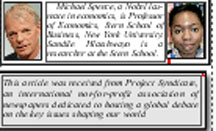By Michael Spence and Sandile Hlatshwayo
NEW YORK – Since World War II’s end, the global economy’s trade and financial openness has increased, thanks to institutions like the International Monetary Fund and successive rounds of liberalization, starting with the General Agreement on Tariffs and Trade (GATT) in 1947. In parallel, colonialism collapsed, and we are now slightly more than halfway through a century-long process of modernization for the many developing countries that emerged. But where has that process led, where is it taking us now, and, perhaps most importantly, how can we influence its course?
With formal barriers to trade and capital flows lowered, several trends combined to accelerate growth and structural change in post-colonial and


